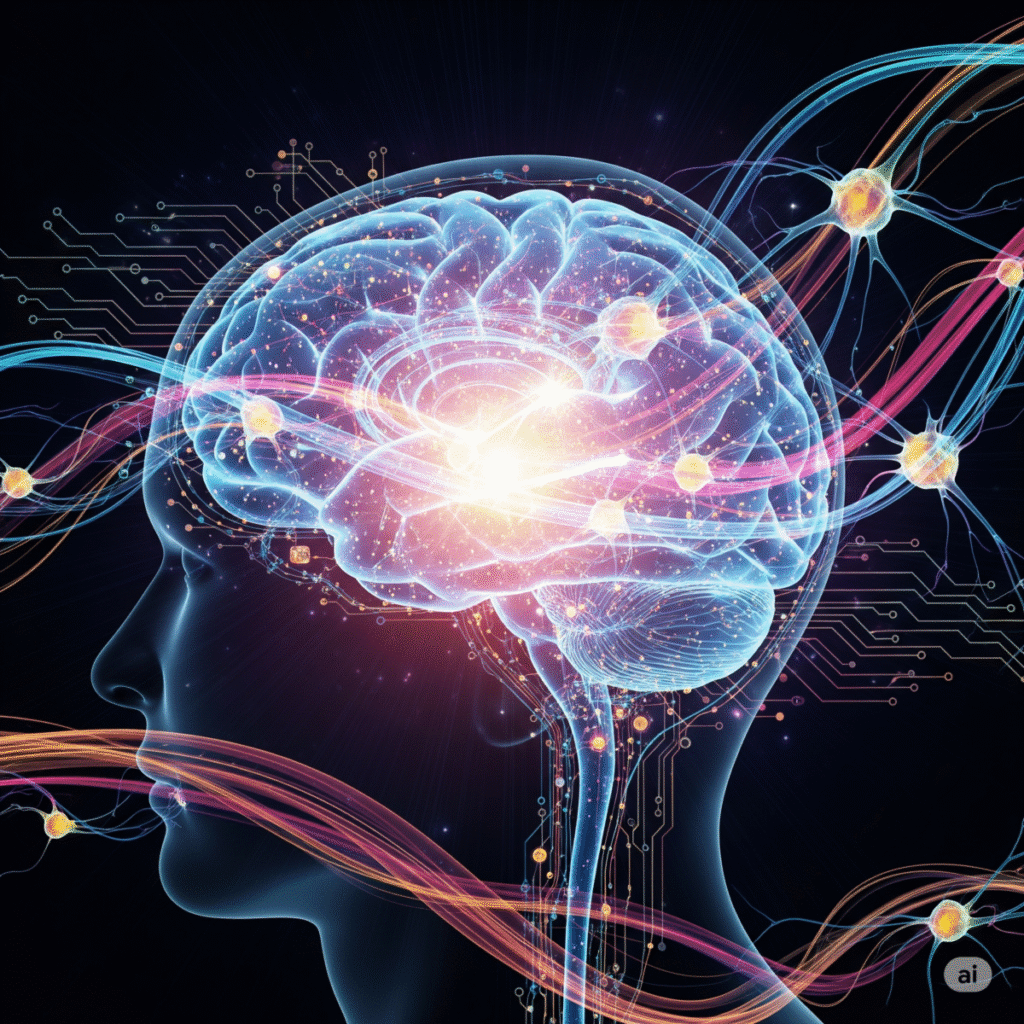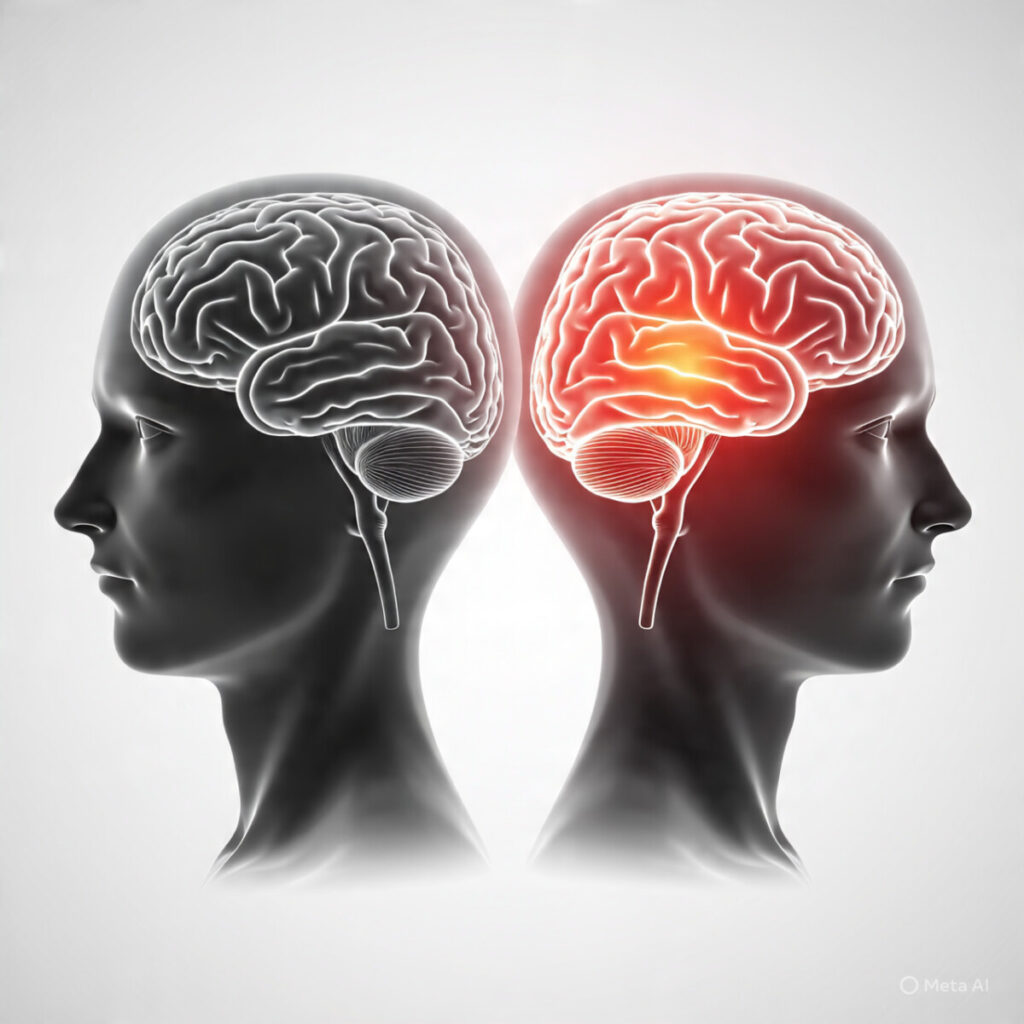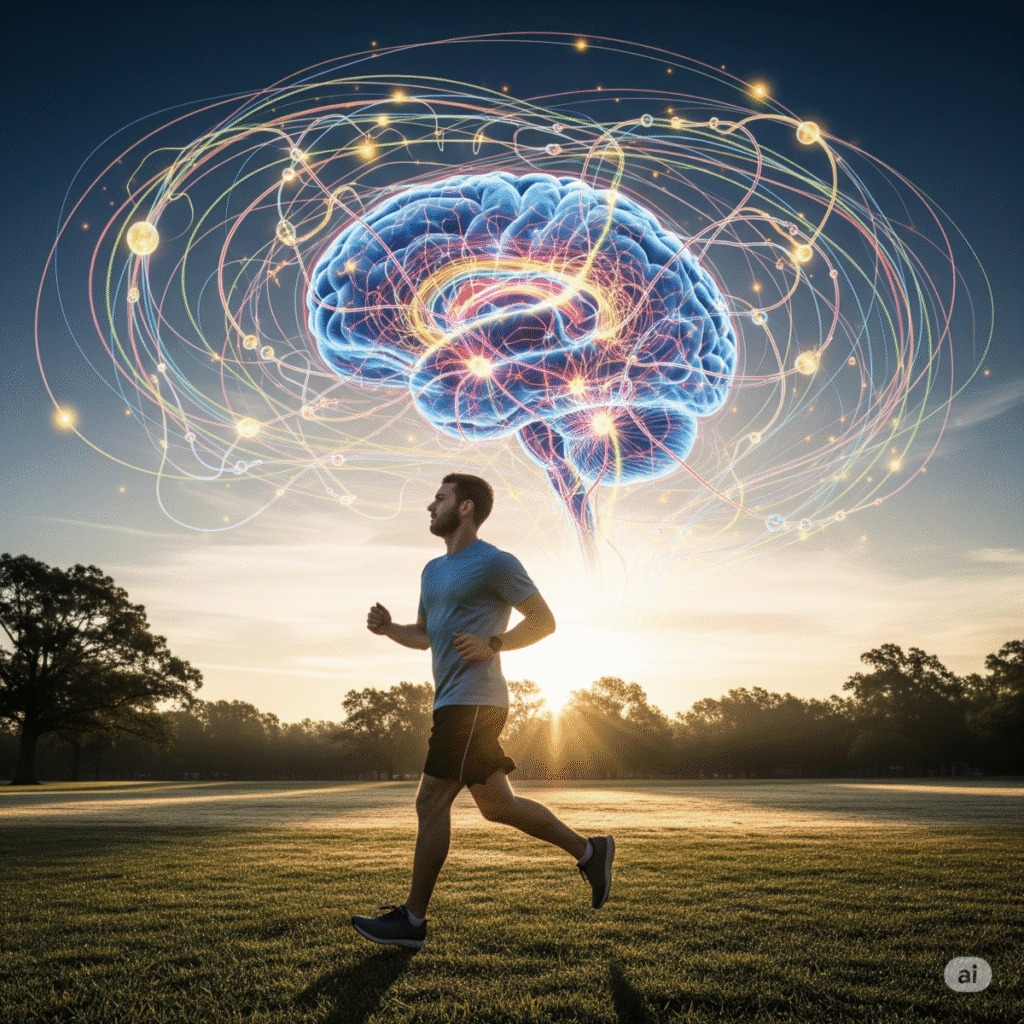Introduction: Your Brain Is More Changeable Than You Think
For decades, scientists believed that the adult brain was essentially fixed—that neuroplasticity was limited to childhood development. This outdated thinking left millions of Americans feeling stuck in patterns of depression, anxiety, and negative thinking. But groundbreaking research has shattered this myth completely.
Neuroplasticity—your brain’s ability to rewire itself throughout your entire lifetime—is perhaps the most hopeful discovery in modern neuroscience. Whether you’re 25 or 75, struggling with mental health challenges or simply wanting to optimize your cognitive performance, understanding how to harness neuroplasticity can literally transform your life.
This comprehensive guide will show you exactly how neuroplasticity works, why it matters for your mental health, and most importantly—the specific, science-backed techniques you can use starting today to rewire your brain for happiness, resilience, and peak performance.
What Is Neuroplasticity? The Science Behind Brain Rewiring
Introduction: Your Brain Is More Changeable Than You Think
For decades, scientists believed that the adult brain was essentially fixed—that neural rewiring was limited to childhood development. This outdated thinking left millions of Americans feeling stuck in patterns of depression, anxiety, and negative thinking. But groundbreaking research has shattered this myth completely.
Neuroplasticity—your brain’s ability to rewire itself throughout your entire lifetime—is perhaps the most hopeful discovery in modern neuroscience. Whether you’re 25 or 75, struggling with mental health challenges or simply wanting to optimize your cognitive performance, understanding how to harness brain plasticity can literally transform your life.
This comprehensive guide will show you exactly how brain rewiring works, why it matters for your mental health, and most importantly—the specific, science-backed techniques you can use starting today to reshape your mind for happiness, resilience, and peak performance.
What Is Brain Plasticity? The Science Behind Neural Rewiring
Brain plasticity refers to your mind’s remarkable ability to reorganize itself by forming new neural connections throughout life. This process involves both structural changes (physical alterations in brain structure) and functional adaptations (changes in how brain regions communicate).If you’re struggling to build lasting habits or feeling stuck in negative thought loops, it might be time to get some structured guidance. A certified health and wellness coach can help you break those patterns and rewire your thinking. Learn how to choose the right coach and start your transformation with our Health and Wellness Coaching Guide.

The Four Types of Brain Adaptation
1. Synaptic Changes: The strengthening or weakening of connections between neurons 2. Structural Growth: The development of new neurons and neural pathways 3. Functional Shifts: The brain’s ability to move functions from damaged areas to healthy regions 4. Cross-Modal Adaptation: When one sensory system adapts to compensate for another
Breaking Down the Fixed Brain Myth
Until the 1990s, the scientific community believed in the “fixed brain myth”—that adult minds were essentially hardwired and unchangeable. Dr. Norman Doidge’s pioneering research revealed this to be completely false. Your brain continues to form new neural pathways, create fresh synaptic connections, and even generate new brain cells well into old age.
This discovery revolutionized our understanding of mental health treatment, learning, and human potential. It means that conditions once considered permanent—from depression to PTSD—can potentially be improved through targeted brain training exercises and lifestyle modifications.
The Mental Health Connection: How Brain Rewiring Transforms Your Mind
Mental health disorders often involve dysfunctional neural pathways that have become deeply ingrained through repetition. Depression, anxiety, and trauma literally change your brain structure—but neural adaptability means these changes aren’t permanent.
How Mental Health Conditions Affect Brain Circuits
Depression and Brain Adaptation: Depression reduces adaptive capacity in areas like the hippocampus (memory formation) and prefrontal cortex (executive function). However, antidepressants and therapy work partly by restoring healthy neural flexibility.
Anxiety and Mental Rewiring: Chronic anxiety strengthens fear-based neural circuits while weakening rational thinking pathways. Through brain plasticity interventions, you can literally reshape these circuits.
Trauma and Neural Recovery: Traumatic experiences create hypervigilant neural networks. Post-traumatic stress disorder (PTSD) involves overactive amygdala (fear center) responses, but adaptive brain changes allow for healing and recovery.
The Hope Factor: Why Brain Flexibility Matters for Recovery
Understanding neural adaptability provides tremendous hope for Americans struggling with mental health challenges. Rather than being victims of your brain chemistry, you become an active participant in reshaping your neural architecture. This shift from helplessness to empowerment is often the first step toward genuine healing.
7 Science-Backed Ways to Harness Brain Rewiring for Mental Health
1. Cognitive Behavioral Therapy (CBT): Rewiring Thought Patterns
CBT is essentially brain rewiring in action. By consciously changing thought patterns, you’re literally reshaping the neural pathways that generate automatic negative thoughts.
How CBT Promotes Neural Change:
- Challenges negative cognitive distortions
- Creates new, healthier thought patterns through repetition
- Strengthens prefrontal cortex control over emotional responses
- Reduces activity in the brain’s default mode network (associated with rumination)
Practical CBT Techniques for Daily Use:
- Thought records: Write down negative thoughts and challenge them with evidence
- Behavioral experiments: Test negative predictions against reality
- Cognitive restructuring: Replace catastrophic thinking with balanced perspectives
2. Mindfulness Meditation: The Brain Flexibility Powerhouse
Mindfulness meditation is one of the most powerful tools for promoting positive brain changes. Regular meditation practice literally alters brain structure within just eight weeks.
Meditation’s Impact on Brain Structure:
- Increases gray matter density in the hippocampus (learning and memory)
- Reduces amygdala reactivity (fear and stress responses)
- Strengthens the prefrontal cortex (executive function and emotional regulation)
- Enhances connectivity between brain regions
Evidence-Based Meditation Practices:
- Mindfulness-Based Stress Reduction (MBSR): 8-week program with proven brain-changing benefits
- Loving-kindness meditation: Increases positive emotions and social connectedness
- Body scan meditation: Enhances interoceptive awareness and emotional regulation
3. Physical Exercise: Moving Your Body, Changing Your Brain
Exercise is often called “Miracle-Gro for the brain” due to its profound neural rewiring effects. Aerobic exercise increases brain-derived neurotrophic factor (BDNF), essentially fertilizer for new neural growth.

Exercise-Induced Brain Benefits:
- Promotes neurogenesis (growth of new brain cells)
- Increases BDNF production by 300-400%
- Improves cognitive flexibility and working memory
- Reduces inflammation that inhibits brain adaptation
Optimal Exercise Protocols for Brain Health:
- Aerobic exercise: 150 minutes moderate-intensity or 75 minutes vigorous-intensity weekly
- High-Intensity Interval Training (HIIT): Particularly effective for BDNF production
- Strength training: Enhances executive function and cognitive control
- Yoga: Combines physical activity with mindfulness for dual brain benefits
4. Quality Sleep: When Your Brain Rewires Itself
Sleep isn’t just rest—it’s when your brain consolidates learning and strengthens new neural pathways. During deep sleep, your mind literally clears out metabolic waste and solidifies the day’s adaptive changes.
Sleep’s Role in Brain Adaptation:
- Consolidates new memories and skills
- Clears beta-amyloid plaques that interfere with neural function
- Strengthens synaptic connections formed during waking hours
- Promotes growth hormone release that supports brain repair
Sleep Optimization Strategies:
- Maintain consistent sleep-wake cycles
- Create a cool, dark sleep environment
- Avoid screens 1-2 hours before bedtime
- Practice relaxation techniques like progressive muscle relaxation
5. Learning New Skills: Challenging Your Neural Networks
Learning novel, complex skills forces your brain to create entirely new neural pathways. This process, called “cognitive reserve,” helps protect against mental health challenges and age-related cognitive decline.
Most Effective Skills for Brain Rewiring:
- Musical instruments: Enhances connectivity between brain hemispheres
- New languages: Strengthens executive function and cognitive flexibility
- Complex physical skills: Dancing, martial arts, or juggling improve motor learning
- Creative pursuits: Art, writing, or crafting activate multiple brain regions simultaneously
6. Social Connection: The Interpersonal Brain
Humans are social beings, and meaningful relationships literally reshape our neural architecture. Social isolation, conversely, creates stress-induced changes that impair brain adaptability.
How Relationships Promote Healthy Brain Changes:
- Activate mirror neuron systems that enhance empathy
- Reduce cortisol and inflammatory markers
- Increase oxytocin and dopamine production
- Strengthen neural networks involved in emotional regulation
Building Brain-Supporting Relationships:
- Engage in deep, meaningful conversations
- Practice active listening and empathy
- Participate in group activities or volunteer work
- Seek professional support when needed (therapy, support groups)
7. Nutrition: Feeding Your Brain’s Adaptive Capacity
Your brain requires specific nutrients to support neural rewiring. The typical American diet, high in processed foods and sugar, actually impairs brain flexibility and promotes inflammation.Alongside powerful brain practices like neuroplasticity, ancient remedies like Himalayan Garlic (also known as Pahadi Lehsun) have shown surprising benefits for brain health, reducing inflammation and supporting cognitive function.
Key Nutrients for Brain Adaptation:
- Omega-3 fatty acids: Essential for neural membrane health and BDNF production
- Antioxidants: Protect neurons from oxidative stress and support growth factors
- B-vitamins: Critical for neurotransmitter synthesis and neural energy metabolism
- Magnesium: Supports synaptic flexibility and neural communication
Brain-Optimized Nutrition Plan:
- Emphasize fatty fish, nuts, seeds, and olive oil for healthy fats
- Include colorful fruits and vegetables for antioxidants
- Choose whole grains over refined carbohydrates
- Consider targeted supplements like fish oil, vitamin D, and magnesium
Advanced Brain Training Techniques: Taking It to the Next Level
Neurofeedback: Real-Time Brain Training
Neurofeedback uses real-time displays of brain activity to teach self-regulation of neural patterns. This technology allows you to literally see your brain waves and learn to modify them consciously.
Conditions Successfully Treated with Neurofeedback:
- ADHD and attention disorders
- Anxiety and panic disorders
- Depression and mood disorders
- PTSD and trauma-related conditions
Transcranial Direct Current Stimulation (tDCS)
tDCS applies mild electrical currents to specific brain regions to enhance neural adaptability. While still emerging, research shows promise for accelerating therapeutic outcomes when combined with traditional interventions.
Virtual Reality Therapy: Immersive Neural Rewiring
VR therapy creates controlled environments for exposure therapy, cognitive training, and skill development. The immersive nature of VR can accelerate brain changes by creating powerful, memorable experiences.

Common Brain Rewiring Myths and Misconceptions
Myth 1: “You Can’t Change After Age 25”
Reality: Brain adaptability continues throughout life, though it may require more intentional effort as we age.
Myth 2: “Brain Training Games Are Enough”
Reality: While brain games may offer some benefits, real-world skill learning and lifestyle changes are far more effective.
Myth 3: “Neural Changes Are Permanent”
Reality: Brain adaptations require ongoing maintenance. “Use it or lose it” applies to neural flexibility—positive changes can fade without continued practice.
Myth 4: “Quick Fixes Exist”
Reality: Meaningful brain changes typically require weeks to months of consistent practice.

Creating Your Personal Brain Transformation Action Plan
Phase 1: Foundation Building (Weeks 1-4)
- Establish consistent sleep schedule
- Begin 10-minute daily meditation practice
- Start regular exercise routine
- Improve nutrition with brain-healthy foods
Phase 2: Skill Development (Weeks 5-12)
- Add challenging new learning activity
- Expand meditation practice to 20 minutes
- Incorporate strength training
- Begin therapy or counseling if needed
Phase 3: Advanced Integration (Weeks 13+)
- Maintain all foundational practices
- Explore advanced techniques like neurofeedback
- Focus on social connection and relationship building
- Consider specialized interventions for specific challenges
Frequently Asked Questions About Neuroplasticity
| Question | Answer |
|---|---|
| How long does it take to see neuroplasticity changes? | Structural brain changes can begin within 2–4 weeks of consistent practice, but significant functional improvements typically emerge after 8–12 weeks. |
| Can neuroplasticity help with severe mental health conditions? | Yes, neuroplasticity-based interventions are increasingly used for severe conditions like treatment-resistant depression, PTSD, and bipolar disorder, often alongside medication. |
| Is it too late to benefit from neuroplasticity if I’m older? | Absolutely not. While neuroplasticity may slow with age, it never stops completely. Adults in their 70s, 80s, and beyond can still create meaningful neural changes. |
| Do I need professional help to harness neuroplasticity? | While many techniques can be self-implemented, working with qualified professionals (therapists, coaches, medical providers) often accelerates and optimizes results. |
| How do I know if neuroplasticity techniques are working? | Look for improvements in mood, cognitive function, stress tolerance, and overall well-being. Formal assessments can also track progress objectively. |
The Future of Brain Science: What’s Coming Next?
Research into neural adaptability continues to accelerate, with exciting developments on the horizon:
- Precision brain training: Personalized interventions based on individual brain patterns
- Combined interventions: Synergistic approaches that multiply adaptive effects
- Technology integration: AI-guided brain training and real-time optimization
- Preventive applications: Using neural flexibility to prevent mental health conditions before they develop
Conclusion: Your Brain, Your Choice, Your Transformation
Brain rewiring represents one of the most hopeful discoveries in human history. No longer are you trapped by your genetics, past experiences, or current mental health struggles. Your mind is literally waiting for you to begin the transformation process.
The techniques outlined in this guide aren’t just theoretical—they’re practical, evidence-based tools that millions of Americans are already using to transform their mental health and quality of life. Whether you’re struggling with depression, anxiety, trauma, or simply want to optimize your cognitive performance, neuroplasticity offers a path forward.
The choice is yours: remain stuck in old patterns, or actively participate in reshaping your neural architecture for greater happiness, resilience, and well-being. Your brain’s incredible capacity for change means that transformation isn’t just possible—it’s your birthright.
Start today. Start small. But start. Your brain is already changing—make sure it’s changing in the direction you want.
Ready to begin your brain transformation journey? Download our free “30-Day Brain Rewiring Starter Kit” with daily exercises, tracking sheets, and evidence-based techniques to kickstart your mental health transformation. Your future self will thank you for taking this first step toward literally reshaping your mind for success.
Start small. Choose one neuroplasticity technique and practice it for the next 21 days. Let your brain surprise you. 💪🧠
👉 Want more? Subscribe to Health Morph and transform your mind, one neuron at a time!






Leave a Reply